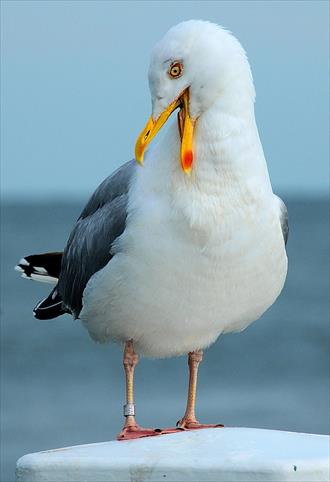What the heck are seagulls doing in Paris?
On a recent trip to the City of Light, biologist James Morris pondered the evolutionary forces that brought these birds from the ocean to the city.

On a recent visit to Paris, I saw all kinds of things I expected — cafés, crêpe stands, street musicians, and art galleries. But I also saw something I did not expect — seagulls. What are seagulls doing in Paris, far from the ocean?
I noticed my first seagull by its characteristic high-pitched call, shouting loudly overhead. I looked up and there it was, perched on one of the buildings lining Rue Bonaparte. Later, walking by the Seine, I noticed several seagulls playing in the air. And, in the garden by Delacroix's studio on Rue de Furstemberg, another one stood proudly, almost defiantly, by the gate.
I associate the sight and sound of seagulls with the beach, where they are as familiar as sand toys and ice cream. Seeing them in the city surprised and encouraged me to figure out what they are doing here.
It turns out that seagulls are very adaptable creatures. They are generalist feeders, which means they eat just about anything — clams, mussels and fish, to be sure, but also garbage, fast food, small rodents, eggs, insects, seeds, fruits and whatever they find on the street. They are true omnivores. So, cities represent a plentiful source of food for the hungry seagulls, especially as fish stocks and nesting grounds along the coast decline.
Seagulls are also very intelligent birds, known for working in groups, communicating with complex calls and having well-developed social structures. They are even able to use tools, using bread as bait to catch fish, for example.
The tall buildings in cities provide ideal nesting grounds for seagulls, high up and far away from predators, not so different perhaps from the coastal cliffs where they first evolved.
So cities are an ideal environment for seagulls. Although they didn't evolve in cities, their behaviors, feeding strategies, resourcefulness and intelligence make them well adapted for city living.
In fact, their numbers along the coast are in decline in many areas, while their numbers inland, particularly in cities, are increasing. In some cities, they are considered a nuisance, where they are known to "steal" food from unsuspecting (and even suspecting) city dwellers. In a recent study in the Netherlands, the authors identify so-called "nuisance events" involving seagulls, which include "noise, defecation, aggression and destruction of rubbish bags."
Seagulls are not the only organisms to evolve in one habitat and then move into another. These organisms often bear the stamp of where they come from. For example, whales evolved from land-based mammals. Today, they still breathe air and have a pelvis (hip bone), formerly used to support their hind limbs. Similarly, seagulls have webbed feet, even though they are of little use to them in urban areas. Perhaps, over time, seagulls will lose this trait.
I also learned that there is really no such thing as a seagull. "Seagull" is an informal term used by lay people. The correct scientific term is "gull" and there are more than 40 different species of gulls. The herring gull is probably the most familiar. Jonathan Livingston Seagull, the protagonist of the beloved book written by Richard Bach, is, in fact, a herring gull.
Some seagulls that have taken up residence in cities far from the coast still return to the coast to breed. But others have taken up more permanent residence in cities, here to stay. As a result, there are two populations of seagulls — one that lives for the most part along the coast, and another that lives mostly inland. There is very little, if any, mixing between the two populations.
I wonder whether these two populations, might, over time, become two distinct species. Speciation occurs when two populations of the same species become separated in some way. A geographic barrier, such as a river, canyon, or ocean, can split a population in two and prevent individuals on one side from interbreeding with those on the other.
Given enough time, the two populations will diverge genetically from each other. Mutations that occur in one population will likely not occur in the other. These mutations will eventually become common in one or the other population, due to the action of natural selection or genetic drift. The two populations will eventually be so genetically distinct that they will no longer be able to interbreed with each other. At this point, they will be two different species.
I could imagine distinct rural and urban species, the gull equivalent of country mouse and city mouse, with different habits and tastes. Perhaps the coastal gulls will start to prefer fish and clams, while the urban gulls will become specialized for crêpes and croissants.
Who knows? Perhaps one day you will find yourself walking in the Luxembourg Gardens, when a seagull swoops down and steals your croissant. Well, as they say, c'est la vie.
Morris is a professor of biology at Brandeis University and the lead author of the college-level introductory biology textbook "Biology: How Life Works." This article first appeared on his blog, Science Whys.
Categories: Research, Science and Technology





